MSC action stories
FR JOHN McGRATH
NIMPUNGI MANTINI
Goodbye my friend
by Sr Anne Gardiner
Fr John McGrath, M.S.C. was a much beloved priest and friend to the Tiwi people of Bathurst Island, not far from Darwin. This account of their "grandfather's" final return amongst his people has been written by Sr Anne Gardiner, a Missionary Daughter of Our Lady of the Sacred Heart.
 |
THE burial ceremonies of the Tiwi people of Melville and Bathurst Islands, based on thePukamuni of the mythical man Purukupali, are by far, the most important events in their ceremonial life.
"These ceremonies, which allow, the Tiwi full expression for their grief, provide at the same time, a complete cultural outlet for their philosophical beliefs, their music, their art, their dancing. No-one, watching these primitive rituals, could fail to be impressed by the obvious pleasure experienced by both the participants and the onlookers." Thus wrote Charles Pearcy Mountford years ago in his study of the Tiwi. (1954)
I begin my tribute to this humble M.S.C. giant, by introducing my readers to the fact that the "Pukamuni" ceremony, the death ceremony, is by far the most important event in their present life as it was in the past.
To work with these people one has to be filled with three gifts:
- Love of God and neighbour.
- A great sense of justice.
- A never failing sense of humour'
And Father John McGrath M.S.C. held all three.
Born in Parkes, the twin son of John and Mary McGrath, he was the 11th child in a family of fourteen.
Upon deciding to become a missionary at an early age he wrote to the then superior at The Sacred Heart Monastery, Kensington, N.S.W. He used to smile as he related the fact that his letter wasn't answered for almost a year, a challenge, to see if he would apply again.
And apply he did. In 1927 he was sent, as a priest, to Bathurst Island, where he worked untiringly until April 1948. Thus he became known as the "Apostle of the Tiwis".
 |
Because of his great love of God and sense of justice to his fellow human travellers he set about learning the language so as to be better able to help these people. He was the man who radioed Darwin about the Japanese flying into Darwin in 1942, a warning that went unheeded. He was the man who stayed with his flock during those turbulent war years.
But it is not McGrath, the forgotten, war-time personage, that I wish to pay this tribute to, but McGrath, priest of God, friend of the Tiwis of North Australia.
News of his death reached us early on the morning of l4th September. The Tiwis, realising that he was an old man knew that this day must come. But when it did come a silence fell upon the town. Their friend, their spiritual Father, who because he had loved much, and because he was so spiritually sensitive had slipped away without a final "nimpungi", goodbye, early one morning in 1948. Tiwis knew they must bring him back for a fitting farewell.
Graciously both His Lordship Bishop O'Loughlin and Sacred Heart Fathers' Provincial Superior Father Frank Quirk gave permission for his body to be burried with the people he loved.
The next two days were spent in story-telling of the memories they held so dear. Huge crowds of women frequented the school yard to arrange appropriate hymns for the Requiem Mass. As is their usual custom, nothing sacred or profane ever comes to a conclusion without argument. And arguments we had, always friendly, yet each wanting her own way in selection of hymns, burial-site etc.
By Saturday, burial day, all was in readiness. The yard was beautifully prepared to receive the body. All vehicles headed for the airport. As the plane flew over their fine sense of humour came out in Faith of Our Fathers lustily sung. I say sense of humour for they chuckled "when he taught us that hymn our fathers were pagans."
Escorting the earthly remains were Bishop O'Loughlin, Fathers Malcolm Fyfe, Tony Bolt, Martin Wilson, Brother Gerry Bourke, Alan White, Sisters Laurencia, Anastasia and Marietta. The body was received and blessed by Father John Savage amid the crying of the older Tiwi people.
The procession to the township could only be described as prayerful. For the vibrancy of the Tiwi people make them a very boisterous race. But today their friend was coming home and deep reverence was shown.
All had been arranged. The sons of the older people carried the coffin. The "girls" (now middle-aged women) whom Father McGrath had stayed with in the bush during the war years sat around his coffin. His "altar boys" sat on the other side. Every man, woman child and dog was present at the Requiem. As the Bishop and Priests entered the tent, "Requiem Aeternam" was taken up.
 |
The Bishop chose Matthew's account of "Whatsoever you do to the least of my brethren you do to me". It made one realize just how well Father McGrath loved his God and because of this love his keen sense of justice came out in all his dealings with his people. His third great gift "his sense of humour", must surely have reached its heavenly triumph when at the time for the Offertory Dance and Procession we had quite a discussion on how it should be done. Meanwhile the Bishop graciously awaited their decision.
As the Mass ended Father John Savage, M.S.C., announced that there was a tape - Fr McGrath's own message to the Tiwi people for June 11th 1982, 71st Anniversary of Bishop Gsell's arrival. If you have been caught up in a surging crowd, perhaps walked the Sydney Harbour Bridge on its 50th Anniversary, you may appreciate something if the crowd that pressed forward in a prayerful silence to hear the feeble, yet powerful voice of their Father giving them his final message. Robust men, the youth of today, those grown old, pressed forward in an alarming silence as they listened to him. Nimpungi yiloti kapi Heaven: "Good-bye until we meet forever in Heaven".
And then peak-hour traffic to the final resting place. Here again the reverence due to such a friend was truly given. No mechanical monster such as a front end loader was to be used to fill this final resting place. No! Each son of the older women took his turn to shovel the red soil of Nguiu on to their "grandfather". I say grandfather for relationships are a very strong binding force on Bathurst Island. The grand-daughters made their own song of grateful farewell to this man.
My own memories of this humble giant are many. My last one is that on 26th April this year, the day I returned to work here, he, an old man. of eighty-nine celebrated Mass at 6 a.m. for me and gave me his priestly blessing.
"Nimpungi Mantini yiloti". Goodbye my friend until we meet in Heaven.
TIWI ISLANDS AND THE CHURCH: COMPASS PROGRAM, ABC RADIO NATIONAL 6th APRIL 2014
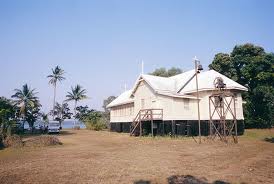

Fr Tan Nguyen MSC
This is the transcript of the Compass program, broadcast April 6th 2014. It can still be watched on ABC I-view or on the Compass website, Past Programs. It is a fine documentary and a positive picture of the relationship between the Tiwi people and the church, starting with Bishop Gsell MSC, with 2014 and Tan Nguyen MSC
Summary
The extraordinary 100 year old story of the relationship between the Catholic Church and Tiwi Islanders ...
For thousands of years the Tiwi believed they were the only people on Earth until the arrival of white settlers. Then, in 1911 a lone priest came ashore to establish a mission on Bathurst Island, 80 km north of Darwin. Father Francis Xavier Gsell evangelised by example, helping build a school and church. A turbulent century of change followed but despite many challenges the relationship between the church and the Tiwi has survived. Today, Father Tan is the priest in charge. How a Vietnamese born refugee came to be ministering to the Tiwi, is a story just as extraordinary as that of the first Catholic missionary who arrived over a 100 years ago ... Compass tells their remarkable stories.
Story
Geraldine Doogue
Hello and thanks for joining me for the enduring and very Australian story of a church and a people.
Set on the Tiwi Islands in Australia's remote north, it's a story that began more than a century ago with the arrival of the first missionary. And it continues to this day in a way that's possibly unique in the world.
Geraldine Doogue , Narration
It's 6.30am and dawn has barely broken as Father Tan Van Nguyen prepares to celebrate mass.
It's a service he conducts several times a week, no matter how many, or few, turn up.
As the interior suggests - this is no ordinary church.
Father Tan is the priest in charge of the Tiwi Islands, near Darwin in Australia's remote north.
This community of 2 500 people has a rich and proud past, and a unique relationship with the Catholic Church.
Father Tan Nguyen, Missionaries of the Sacred Heart
We are lucky in a sense that the church encourage to combine our culture and the Catholic faith, how that blend together. And it works quite well.
This is Jesus. Behold the Lamb of God. Behold Him who takes away the sins of the world. Blessed are those who are called to the supper of the Lamb. The Lord be with you.
Narration
How Father Tan - a Vietnamese born refugee -came to be ministering to the Tiwi, is a story just as extraordinary as that of the first Catholic missionary who arrived here more than 100 years ago ...
Archive Footage from Islands of Australia "The Only People 1973)
"Cut off from the mainland of Australia for some twenty to thirty thousand years they became isolated from the mainland to a point where they call themselves the Tiwi, meaning the only people"
Narration
The Tiwi Islands lie 80 kilometres north of Darwin in the Arafura Sea, off Australia's northern coastline.
Melville is the largest island, but Bathurst – The smaller and more populated – is where the first Catholic mission was established more than a century ago.
Father Francis Xavier Gsell was born in Alsace on the French-German border, and as a young man, joined the Missionaries of the Sacred Heart.
After postings in Papua New Guinea and Darwin, Gsell set his sights on Bathurst Island, - arriving in 1911.
Anne Gardiner, Retired Nun, Bathurst Island
And he was noticed by two elderly Aboriginal men and they wondered what this strange man was who was walking up and down with a book, reading a book which he was saying his prayers. And they watched him, they watched him build a house. And then they started to make contact with him.
Narration
Gsell had little support or money and lived, in those early days, somewhat 'nervously', but was apparently 'sincere, kind and determined'.
He learnt the Tiwi language, and provided medical care.
Anne Gardiner
Many people damn the missionaries for coming in and just baptising people, but he did not start that way. He started fixing up their ailments and making sure that he got to understand them.
Narration
Sister Anne Gardiner actually met Bishop Gsell, as he became, in Sydney 60 years ago, on her way to her new posting on the Tiwi Islands.
Anne Gardiner
He was a physically big man. He had a very strong voice. He had a very white beard and he had penetrating eyes.
And I asked him what will I do? I'm going to Bathurst Island. And he looked down through his beard and looked deep into me and said two words, 'Love them'.
Narration
Gsell's effort to introduce Christianity to the Tiwi people is documented in Bathurst Island's museum.
Anne Gardiner
It hasn't been a difficult process because they are very spiritual people. They have their own spirits. So therefore they understand that the Great Creator also is a spiritual person.
And then you look around and they take what symbols they have and what meaning for their symbol and then, if we feel, yes, that fits in, that's how we put it into Christianity.
What we're looking at here is the creation story and their creation person was a woman, a female. And when you read it in English it's very much like the Genesis story.
Narration
Father Gsell evangelised by example, helping build a store, school and a church.
With 18 months food gardens were planted and living quarters erected.
Soon the church sent reinforcements -
priests and nuns.
Anne Gardiner
They lived the life with them. They weren't above them, they worked with them and I think that's the very important thing when you're with indigenous people.
That you become part of them and don't expect them to become part of us.
Narration
Unlike some missionaries, Father Gsell left many sacred traditions alone.
Among them the Pukumani burial ceremony.
The Tiwi are famous for their sacred poles
used in traditional funeral rituals.
Today they stand alongside Christian crosses, evidence of the coming together of the two belief systems.
Marius Puruntatameri, Pirlangimpi Community Melville Island
We believe that when people die their spirit goes to their traditional land. But it doesn't go immediately.
It goes after the Pukumani ceremony is performed. That's one of the reasons why a Pukumani ceremony is performed, to move the spirit of the person from one place to his country.
Narration
But one traditional practice Gsell wouldn't ignore.It involved young girls and much older men. And in 1921 he devised a unique method of circumventing it, in keeping with tribal law.
Barbara Tippolay, Sister Handmaidens of Our Lord
In the old days the young girls were promised to old men and when the missionaries came Bishop Gsell stopped it in a way by buying them or paying the old people tobacco and axes in order to get a girl to go to school. And then to give her the freedom to choose who she wants.
Narration
Over time the Tiwi would bring their daughters to Gsell for the Sisters to teach and care for.
He was called "The Bishop with 150 Wives" which became the title of his autobiography published in the 1950s .
After morning mass, Father Tan's day starts in earnest ... Working alongside Father Tan is Patrick, a trainee priest, soon to be ordained.
Today they're calling on people too sick or infirm to go to church. Most older Tiwi islanders would have attended Mass as children.
Father Tan
The Lord be with you. Today Jesus reminds us to bring Healing and Grace into our world. And ask for healing and grace on you, eh, and God to bless you. Let us pray. Our father who art in heaven ...
Woman
He come. Talk to me, pray over me. Make me good.
Patrick Mara, Missionaries of the Sacred Heart
Part of this is like a healing ministry. A gentle touch, holding their hand. It brings comfort to people. It just brings a sense of peace and tranquility, and, yes, a passing on of gentleness of spirit.
Father Tan
May the Lord Jesus Christ who went about doing good work, healing the sick, grant that you have good health and be enriched by His Blessing.
Father Tan
In my training for priesthood I was attracted to people who are on fringe of society. So I've been working with homeless for six years in Sydney and with that I started to learn more about the human strength and weaknesses.
God bless you
Woman
God bless you, Father. Thank you for coming
Father Tan
And that reflected for me what my journey is about, how I discover God.
Narration
Father Tan's own life journey had a difficult start. He was born in Vietnam and grew up during the war.
Archive Footage
The villagers are frightened. They have no way of knowing they are not the target.
Narration
Afterwards, he was among the tens of thousands of refugees who fled to Australia, arriving when he was just a boy.
Father Tan, Missionaries of the Sacred Heart
And we as a family left Vietnam on a boat at the end of 1980 and been picked up by the German oil tanker on our fifth day at sea.
I think it did change me because when I reflect back on my life I'm thinking what god planned for my life and all that in the past have some influence on that.
Narration
In 1936 Father Gsell left the Tiwi islands, to become Bishop of Darwin.
By then some 450 Islanders had been baptised. And building had begun on Bathurst Island's iconic wooden church.
Despite its isolation, the Mission would play a memorable role in World War Two.
In 1942 Japanese warplanes flew over Bathurst Island, strafing the church ... The mission radioed Darwin about the fleet of enemy bombers heading its way.
But the warning went unheeded. By day's end hundreds were dead.
Darwin, its harbour, warships and airfields were all destroyed, in the first and worst ever attack on Australian soil.
Narration
The Tiwi have immortalized the devastating attack in a ceremonial dance – The Bombing of Darwin dance.
The Catholic Church here played its part in another modern day tragedy. In 1940 a mission was built on Melville Island for so-called 'half-caste' children.
Barbara Tippolay, Sister Handmaidens of Our Lord
That was the government policy, putting all – I don't like to say the word - the half-caste people together in a different place. Why? I don't know. They must have thought it was the best thing for the children. But they broke up a lot of families.
Narration
The youngsters were taken from aboriginal families from all over Australia, to live on the mission at Garden Point.
Barbara Tippolay
Yes I was one of them. But I found my family afterwards.
Narration
Sister Barbara was taken from her family on Bathurst Island.
Barbara Tippolay
For me I was here with my people. We had school and everything but the people were here. That Stolen Generation, it's very painful because not knowing their families and being taken away.
Narration
Sister Barbara, a Tiwi Islander, has been a missionary nun for over 50 years.
Barbara Tippolay
Well, I don't see any conflict being a Religious and a Tiwi. I think it's wonderful.
Freely you have chosen to take another to become a Religious and have that deep, that faith of my ancestors is still there and it makes it more rich when the Christianity is blended in together.
I don't think you can separate the two. You're one person.
Narration
By war's end, a newcomer had arrived on Bathurst Island ... one who'd help make the Tiwi famous.
Brother John Pye, a shy and unassuming school teacher, introduced the young men to Aussie Rules football ... to stop them spear fighting.
Archive Footage, Brother John Pye
They're made for it. Nobody can go in after the ball like they can. They're so sprightly; they get in every grand final and every big occasion in Darwin.
Narration
The Tiwi Islanders have produced many AFL heroes. David Kantilla was the first player to go South.
Later, Michael Long who captained Essendon. And Maurice Rioli who kicked 80 goals for Richmond in the 1980s.
The post-war years saw the Mission flourish.
More houses were built. They grew peanuts, established a forestry and logging business, and a sawmill.
The women excelled in dressmaking, winning prizes at the Darwin Show.
The islanders grew their own fruit and vegetables, and were virtually self-sufficient.
It was around this time that Sister Anne arrived.
A nun and teacher, she was just 22.
Anne Gardiner, Retired Nun
When I first came I got off a plane on the 23 November 1953 and I was met by four sisters and all these beautiful children.
And the school was underneath the old church and a dirt floor, long benches, that was all we had. And I taught there from '53 til '57 when the first schoolrooms were built.
Eustace Tipiloura
We used to have a slate and the chalk. That's where we started.
Narration
Eustace in fact wouldn't be here today if it weren't for the Mission.
Eustace Tipiloura
I'm a twin, the twin they used to kill one. I was the only bloke, they were going to kill me. Thanks for the nuns they said no you can't do that or we'll have to, so they did
Anne Gardiner
This is the women's section, shoe department as you can see...
Narration
The classroom that Sister Ann first taught in
is today an Op Shop.
Anne Gardiner
Sheets, towels, etc here. And then you come to the children's across there and the Men's department is up here.
Shopper
Get this sheet. Buy it for my family.
Anne Gardiner
Now it has become something for the Tiwi people because the clothing is very expensive for them to buy.
SINGING - We are going, we are going, we are going for freedom...
Narration
The 1967 Referendum saw big changes for Australia's indigenous people.
Segregation was discouraged. As was discrimination. Assimilation and integration actively promoted.
SINGING - Yes, yes, yes for freedom...
The Mission's role was changing.
Archive footage - A Big Country "The First Territorians" 1969
Generally speaking we're educating the aboriginal people to our way of life, to our society with a view to them becoming part of us completely without any sort of training and so forth.
Priest, Archive footage - A Big Country "The First Territorians" 1969
And, as missionaries, of course, we do this mainly through religion and bringing to them through our religion the basic way of living as we know it in our modern civilisation.
Narration
There was a feeling of optimism for the future as this documentary of the time attests.
Archive footage – Islands of Australia "The Only People" 1973
Since then they have worked together with the mission fathers improving their village in many ways. Modern vehicles, tools and materials have become available. This meant an increase in jobs for them. Everybody works.
Narration
The mission was thriving: It had a priest, three brothers, 5 sisters and 3 lay missionaries
But times were changing. It was the era of Land Rights and self-determination.
Anne Gardiner
And when they asked for self-determination, yes. The people here they said we'll give it a go, go alone. But leave the sisters in the school, in the clinic.
So we felt that we were invited to stay. And so that's why we stayed. Had we been told to go we would have gone.
Narration
In 1975, 15 Tiwi Islanders joined an aboriginal pilgrimage to Rome to meet the Pope.
Three years later in 1978 ownership of the islands was handed back to the Tiwi to manage their own communities.
Federal money poured in. But, over the next decade or so, drinking, unemployment and welfare dependency began creating problems.
Narration
Then a bombshell struck at the heart of the mission itself.
Reporter , Archive footage – The 7:30 Report
For more than 80 years the church has been a powerful force on Bathurst Island.
Although details are sketchy it's alleged that around 50 children between eight and fourteen years of age have been sexually abused.
A former Christian Brothers school principal is now being investigated by police.
Narration
The Tiwi's difficulties climaxed in a devastating suicide epidemic of young men and boys which peaked in 2005.
Reporter, News Archive Footage
The deaths of 5 young Tiwis last year has led to a great deal of soul searching ...
Narration
Alcohol, drug abuse and gambling were blamed ... there were also calls for the church to pull out of the schools.
Teacher in Class
Remember this one?
Narration
The Tiwi voted to keep the church on and today the primary school is an integral part of the community.
Ian Marmont, Principal
If you get one of these it means you have been doing really good things all term. So you should be very proud of yourself because we are all very proud of you.
I think it's the greatest gift we can give the children is to give them a good education.
... a tee-shirt, a cap ..
I think it's absolutely vital. That's what we try and stress to the children. Come to school every day.
Get a good education and it gives you lots of options as to what you do with your life and where you go in your life.
Narration
Father Tan and Sister Anne are both regular visitors and active helpers at the school...
Anne Gardiner
I try to support them in every way that I can. I support them in their religious instruction.
Whenever I am invited I go to the school. I'm always around where children are to listen to their stories.
Anne Gardiner
The Catholic Church is here because the Catholic Church is not a building. The Catholic Church is people.
Tiwi People
Sing evening Mass.
Narration
For more than 100 years the Catholic Mission has journeyed with the Tiwi.
Together they've adapted to challenging times and to each other ...
Today Father Tan has a new goal, to conduct mass in Tiwi and English.
Father Tan
And for the last few years I'm learning Tiwi and also I've been part of a Mass we sing in Tiwi and celebrate in Tiwi in the Mass.
Anne Gardiner
The church is alive and well here. And there's a great relationship between Tiwi and the Religious who've worked here.
And their love, their support and above all their forgiveness for any of our stupidities is something that we cherish.
Marius Puruntatameri
There's a lot of energy in having both the religious, the Christianity and our Tiwi spirituality.
We just come to accept both. They both go hand in hand. It's wonderful.
Great Supporter and Friend of Aboriginal Christianity Father Frank Fletcher MSC
Catholic Communications, Sydney Archdiocese,
21 Nov 2013
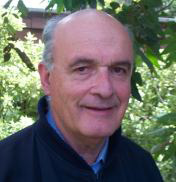
Father Frank Fletcher MSC, DTheol
One of the founders of the Archdiocese of Sydney's Aboriginal Catholic Ministry (ACM) and one of the city's most well-known and beloved priests, Fr Frank Fletcher MSC is gravely ill.
The 81-year-old cleric was admitted to Prince of Wales Hospital yesterday and this morning speaking on behalf of the family, his sister Terry Fletcher asked the people of Sydney for their prayers.
"Our brother has been very frail for some months now and he needs our prayers at this time," she told Catholic Communications this morning.
Fr Frank is due to celebrate his 82nd birthday on New Year's Day in just over six weeks' time.
Despite his age, he has just written a ground breaking book which reveals his profound understanding of Aboriginal spirituality and argues that in addition to a more authentic dialogue with Indigenous Christians, there is a need for a sympathetic understanding of the Dreaming which will deepen our own religious experience and help renew modern Christian Theology.
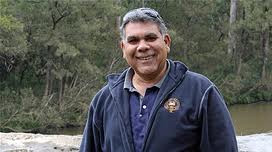
Graeme Mundine says Fr Frank has been an inspiration to Aboriginal people as well as the wider community
"Jesus and the Dreaming: Discovering an Australian Spirituality through Aboriginal-Christian Dialogue," published by St Paul's (rrp $24.95) is currently being printed and should be available within the next few weeks. But already international as well as national orders are being taken via the St Paul website for Fr Frank's book which is a collection of his writings over many years on Aboriginal spirituality and the challenges and possibilities for Western Christianity.
According to Fr Frank's sister, the book is a culmination of her brother's life's work.
"An editor collected his writings and he has been involved with updating these as well as overseeing everything that has gone into the book every step of the way," she says.
Terry is also particularly proud the cover chosen for the book is a reproduction of "The Last Corroboree," a superb painting by acclaimed Aboriginal artist Richard Campbell.

Fr Frank Fletcher honoured by Sydney Aboriginal Catholic Ministry 2013
In February this year, Fr Frank was honoured by the ACM at a special Mass and celebration lunch at the Church of Reconciliation at La Perouse where he was presented with a beautiful print on canvas of The Last Corroboree in recognition of the role he played in the founding of the Aboriginal Ministry and the unstinting support and encouragement he had given over many years.
Graeme Mundine, well known elder and executive officer for the Sydney ACM and Dr Elsie Heiss, another much loved elder and a member of the Wiradjuri nation who worked closely with Fr Frank to establish the ACM which began as a small room in the presbytery of St Mary's in 1988, were among the many who attended the celebration.
At the La Perouse Church of Reconciliation hundreds arrived to thank and pay tribute to Fr Frank.
During the lunch Sydney's Aboriginal Catholic community recalled how he had been asked many years before "Why have an Aboriginal Church?" To which Fr Frank had replied: "The Reconciliation Church is an asset to the community because faith gives strength against difficulties and people of faith are able to take on hard roles. A community needs to have an inner unity."
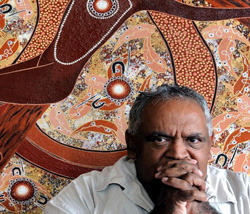
Artist Richard Campbell who painted the Aboriginal Stations of the Cross...
Graeme Mundine described Fr Frank today as someone who as a theologian had helped raise the thinking and awareness among the wider community about Aboriginal spirituality and its place in Christianity.
At the Church of Reconciliation as well as at St Mary's Erskineville where the ACM holds Mass on alternate Sundays, the liturgy, Lord's Prayer and Mass reflect the Aborginal people's deep spirituality, culture and traditions.
The Mass incorporates specially written Aboriginal prayers and often includes Aboriginal dancers and music such as the didgeridoo. In addition the Aboriginal Rite of Water Blessing and the Aboriginal Rite of Smoking or Fire are frequently included as Penitential Rites.
"Fr Frank has been exemplary in his tireless and unstinting support of the Aboriginal community and has been a good friend over many years. And although there is still a way to go, he has been instrumental in not only helping Aboriginal people discover Christianity but has enabled them to discover Aboriginal Christianity," Graeme says.
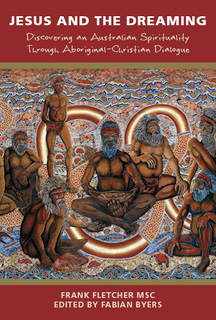
Jesus and the Dreaming: Fr Frank Fletcher's book due out later 2013
He explains that before people like Fr Frank, Fr Ted Kennedy and Mum Shirl, few understood that Aboriginal people had difficulty relating to Western Christianity. They had no idea about Northern Hemisphere animals that are used in many of the metaphors in Western Christianity.
"The Spirit of the Rainbow is our symbol of God crossing the entire sky which brings a whole new mindset for the modern Church and recognises the different symbols and concepts that represent God not only to the Aboriginal people but in other non-Western cultures," Graeme says and believes this is shows just how truly global the Catholic Church is.
"We are all Catholic and share Catholic values but the concept and symbols we use for God and the Scriptures may be different depending on our individual history, culture and spirituality across a wide variety of non European cultures."
He strongly believes Fr Frank has helped change perceptions within the Church about Aboriginal spirituality and how this can enrich Western Christianity and the Catholic Church in particular.
"We are all keeping Fr Frank in our prayers at this time," he says.
In addition to his close involvement with Sydney's Indigenous community and the ACM, Fr Frank has also been a long time supporter of St Vincent de Paul Society's Matthew Talbot Homeless Services extending the hand of friendship and providing pastoral and practical care to some of society's most vulnerable and in need.
Here are some MSC stories that tell of priests and brothers in action. More stories will be added as they come to hand, so please visit this page again.
 HyVong - Journey towards Hope
HyVong - Journey towards Hope
In Bowral in 1980 a small refuge and home called HyVong was formed by Father Strangman, of the Missionaries of the Sacred Heart. It lasted just four years, but it gave 'hope' to almost 50 detached and unattached Cambodian and Vietnamese young men, fleeing Communist reprisals against them after the Vietnam war and the horrors of the Pol Pot years in Cambodia.